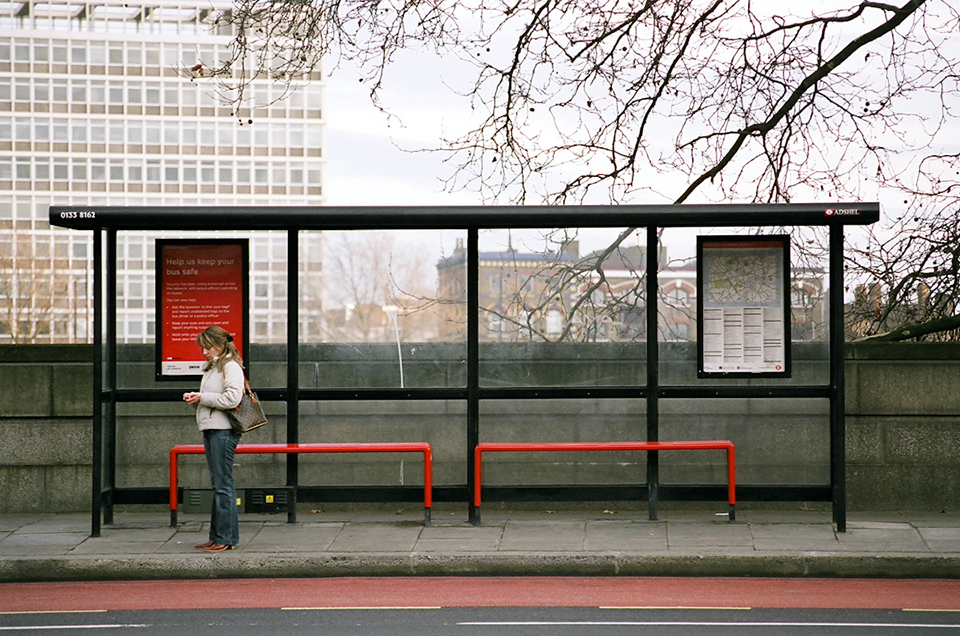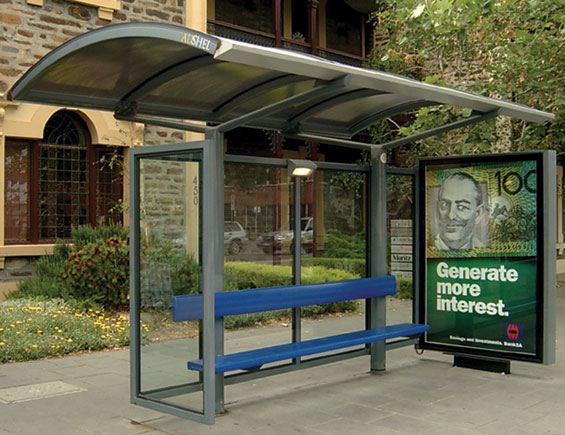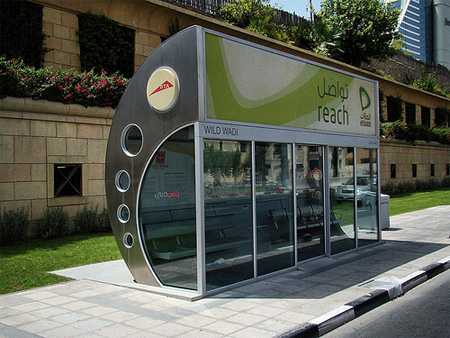Bus stop
A stop is a location on a line of local public transport (LPT ), which is operated as planned or at least regularly by trams, trolleybuses, buses or other urban transport, to allow passengers to get on and off. If there is a bus stop right on the street, grab special traffic regulations on all vehicles, especially in passing and parking.
The " stops" of Pedibus ( " walking school bus " ), however, does not hold a vehicle, school children gather at specified times, to walk together along a set route to school.
- 2.1 bus bay
- 2.2 Conventional stops Island
- 2.3 Kaphaltestellen
- 2.4 Traversable Kaphaltestelle
- 2.5 Covered stop
- 2.6 request stop
- 2.7 Double Stop
- 2.8 Direction stop
- 2.9 exit stop / boarding stop
Situation in Germany
Terms of Use
In Germany, a stop is one with the traffic sign 224 of the Road Traffic Regulations ( Highway Code ) selected device in the road network on which a public transport runs regularly holds ( spontaneously or as required maintenance ) or on request. Each 15 meters in front of and behind the traffic signs Parking is prohibited. Traffic Technically it is a linking point between public transport and walking.
Signs
By 1939, Germany had no single stop sign. As a rule, were rectangular signs with the inscription tram stop cars stop or similar set up at the bus stops. The still used yellow-green H sign was on the basis of the law on the carriage of passengers on land, in the version of 6 December 1937, the authorization of the Minister of Transport to adopt the necessary legal regulations concerning the operation of the transport companies ultimately contained therein the computational Transport Ministers on July 19, 1939 introduced by publication in the German Reich and Prussian State Gazette No. 172, which states:
The stops signs for trams is a circular yellow disk with green trim and green H. The diameter of the disc can be 35 or 45 cm. The stops signs for road services is a yellow sign in the form of a grüngerändertes Sign interrupt whose circular end H and its arm, the reference number of the motor vehicle line - both in green - contains. The circular end of the character is supposed to have 25 or 35 cm in diameter. The arm is 50 cm long up to the middle of the letter H.
Under this scheme, all stops in the German Reich should be provided until 1 April 1941, the new standard mark. Because of World War II that has not been carried out and the stop sign was then introduced in Germany in fact only after the war.
The stops signs for trams and cars lines were not only different in their characteristics, it was beyond well as arrangements for the designation as a double stop, for attachment to cantilevers and met on the formation of a light column, including the color scheme, even the sign posts.
Later the stops signs have been integrated into the Highway Code and combined into the single still valid characters 224 stop for trams and buses.
Method of construction
Modern stops are designed for disabled people. When getting in and out is not a step to overcome. There are various possibilities:
Bus bay
In a bus bay or bus bay is a roadway widening, where the bus stops not on the road, but on the side of the road space. The entry and exit is made without obstructing traffic flow.
Conventional stops Island
A conventional bus stops island is normally between the lanes of car traffic. These have the pedestrian crossing to reach the island, which may require lights and safety gate at the rear of the platform.
Kaphaltestellen
In a Kaphaltestelle the sidewalk is preferred to the tracks or the tracks are pivoted thereto. This is the safest form of stops, since a and disembarking passengers have to cross any roads.
About Mobile Kaphaltestelle
In a traversable Kaphaltestelle, also called driven over Haltestellenkap, the roadway located between the track and walkway is raised, so that a level of the same transition from the walkway to the rail vehicle. Often, the road surface is modified with respect to the visibility of the stop and a speed reduction in stops or ramp area. If a traffic light for securing the passenger exchange used against the other road, also from a dynamic stop ( island time ) is spoken.
Covered stop
Covered bus stops are out under the term waiting areas and the preamble street furniture. In major cities are located at many stops ticket machines. Also a schedule and information boards to operate at the bus stop are attached there is usually so that potential passengers can obtain information about network tariffs, and the arrival and departure times of there holding transport. But vandalism is particularly often at bus stops and often leads to significant damage. At shelters of stops billboard advertising is often attached.
Request stop
Request stops only be approached by request - terminals with user interfaces also allow people without a phone to book a ride. The terminals can be supplied with light or electricity by photovoltaic. The user interface consists of vandal resistant alphanumeric or graphic display and one or more push-buttons (keys).
In some countries ( eg in the Netherlands) request stops are sometimes set up on motorways or motorway-type roads. In this case, the waiting passenger operates a switch in the bus stop area, which in turn activates a signal several hundred meters from the bus stop. By this signal, the bus driver is informed that at the next stop passengers want to climb and he has to go to reduce the speed and the (usually in a holding bay, similar to a highway parking lot, away from the highway lying ) next stop.
Double stop
Double stops can be approached from two or more vehicles. Characterized the mutual transfer is possible, but requires a long way, if more than two vehicles stopped.
Formerly a shield with two H in the circle of the stops for this shield was common in Germany, this indicated that the vehicle stopped only once for passenger transfer at this stop, but this did not necessarily happen at the foremost position of the stop.
Direction stop
If a station operated only in one direction, then one speaks of a direction stop. The reason for setting it up is usually the leadership of a line by a two-way street. Also, lack of space to set up a bus stop opposite or inappropriate crossings of a road can make direction stops required.
Exit stop / boarding stop
At end stations, mostly before turning loops, pure exit stops are often encountered. There, the entry is prohibited, so that the vehicle can drive on the turn system without passengers or the staff a break is possible. Similarly, the first stop is after the turning process is often a pure entrance station. Even so-called operation can prohibitions cause may only be boarded at stops only on or off. For example, no transport their passengers in only one or erupting transport within cities, many regional bus companies. Thus, a competition is impeded urban bus companies.
- Various stops
- Hamburger stop signs ( here: Jungfernstieg )
- In Turkmenistan
- Austrian flag stops
- Tram stop in Vienna
- Bus stop of regional transport in Flanders
- Bus stop shelters in DDR construction
- Covered stop in Erkelenz
- Information boards at the meeting point stop, bus Lemgo
- Munich S -Bahn station Hirschengarten ⊙ 48.14335340209511.518800258636
- Rural one-person waiting house with solar light in West Chapel ( NL)
- Easy construction: Single Haltestellenschild ( Ilmenau)
- Bus station of the Swiss regional transport (Bus ) to Chur
- FUN (K) Bähnle, Kressbronn / Langenargen
- Bus stop in Sweden










